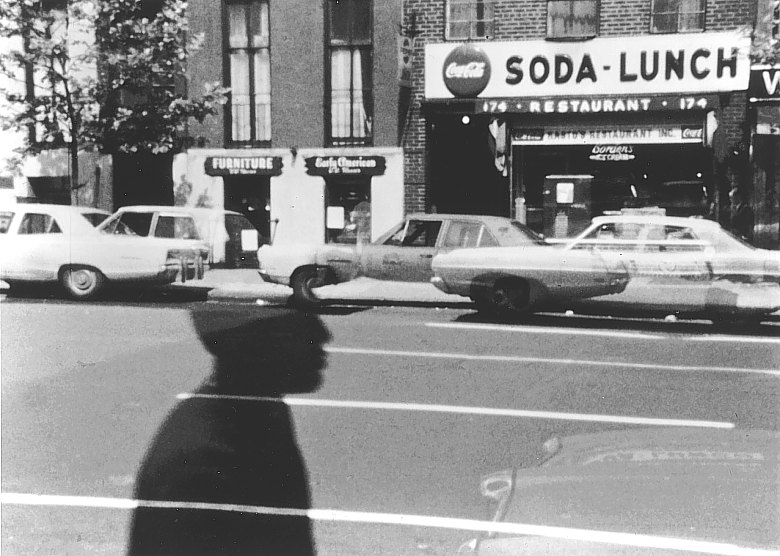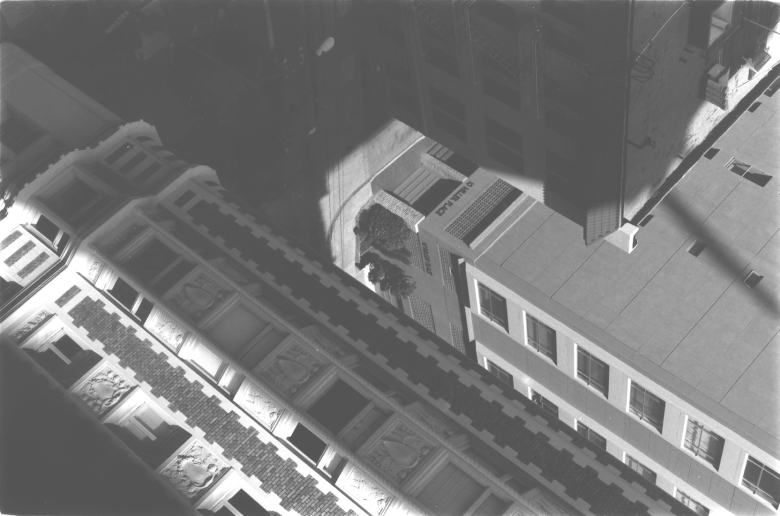3.12.12
Ernie Gehr
9:27 AM
GENERAL INTRODUCTION:
"For nearly forty years, Ernie Gehr has been making cinematic magic, often from the least likely materials. Indeed, Gehr’s most famous film, Serene Velocity (1970), in which the filmmaker transforms an institutional hallway in the basement of a classroom building at the State University of New York at Binghamton into a nexus of visual and conceptual energy, merely by adjusting his stationary camera’s zoom lens every four frames for twenty-three minutes, can be read as Gehr’s manifesto. For Gehr the most everyday spaces and the most mundane actions offer the imaginative filmmaker the most interesting potential. No other filmmaker, with the exception of Michael Snow, has so relentlessly and so productively explored the capacity of filmmaking to develop the visual (and auditory) opportunities afforded by the cinematic apparatus itself."
(Scott MacDonald in A Critical Cinema 5)
---
Morning (1968)
Wait (1968)
Reverberation (1969)
Transparency (1969)
History (1970)
Field (1970)
Serene Velocity (1970)
Still (1969-71)
Shift (1972-74)
Eureka (1974)
Behind the Scenes (1975)
Table (1976) .
Untitled (1977 (1977)
Untitled − Part One (1981)
Mirage (1981)
Signal − Germany on the Air (1985)
Rear Window (1986/91)
This Side of Paradise (1991)
Side/Walk/Shuttle (1991)
For Daniel (1992-96)
Cotton Candy (2001)
Glider (2001)
Crystal Palace (2002; revised and released as HD in 2011)
City (2002)
The Collector (2003)
Passage (2003) [16mm film]
Precarious Garden (2004) [16mm film]
The Collector (2004)
The Astronomer's Dream (2004)
Essex Street Market (2004)
Noon Time Activities (2004)
Workers Leaving the Factory (After Lumiere)
Greene Street (2004)
Before the Olympics (2006)
Shadow (2007)
10th Avenue (2007)
The Dutch Arrive in New York (2007)
Daily Commute (2007)
New York Lantern (2008)
Waterfront Follies (2008)
The Search for Mechanical Life (2008)
Abracadabra (2008)
Urban Sightseeing (2009)
Hurry Up Henrietta (2009)
19th Century Mechanical Magic Lantern Slides & Dissolving Views (2009)
Auto-Collider (2009)
Auto-Collider II (2009)
Auto-Collider III (2009)
Auto-Collider IV (2009)
Auto-Collider V (2009)
Auto-Collider VI (2009)
Thank you for Visiting (2010)
Mist (2010)
Auto-Collider VII (2010)
Auto-Collider VIII (2010)
Auto-Collider IX (2010)
Auto-Collider X (2010)
Auto-Collider XI (2010)
Auto-Collider XII (2010)
Chambers of Time (2010) [HD]
Super Realism (2010) [HD]
On The Boardwalk At Coney Island (2010) [HD]
Picture Taking:
[This is available for standard single channel *HD* projection,
in addition to being a 3-channel installation piece.]
Auto-Collider XIII (2011)
Auto-Collider XIV (2011)
Auto-Collider XV (2011)
Auto-Collider XVI (2011)
Auto-Collider XVII (2011)
Auto-Collider XVIII (2011)
Auto-Collider XIX (2011)
Work-in-Progress (2012)
Departure (2012) [HD]
Brooklyn Series I (2012)
Brooklyn Series II (2012)
Photographic Phantoms (2013)
Winter Morning (2013)
The Quiet Car (2013)
Auto-Collider XVIII (2013)
Brooklyn Series (2013)
INSTALLATIONS:
MoMA On Wheels (2001)
Navigation (2001)
Panoramas of the Moving Image:
19th Century Mechanical Magic Lantern Slides & Dissolving Views (2005) (5-channels)
Ocean Avenue (2005)(4-channels)
Crossing The Bowery (2006)(3-channels)
Water Series (2007-08) (approx. 50 single channel pieces)
Water Front (2008)(two 4-channel pieces)
Surveillance (2010) HD ((4-channels)
Picture Taking (2010) HD (available as either a single channel or a 3-channel work)
Wait (1968)
Reverberation (1969)
Transparency (1969)
History (1970)
Field (1970)
Serene Velocity (1970)
Still (1969-71)
Shift (1972-74)
Eureka (1974)
Behind the Scenes (1975)
Table (1976) .
Untitled (1977 (1977)
Untitled − Part One (1981)
Mirage (1981)
Signal − Germany on the Air (1985)
Rear Window (1986/91)
This Side of Paradise (1991)
Side/Walk/Shuttle (1991)
For Daniel (1992-96)
Cotton Candy (2001)
Glider (2001)
Crystal Palace (2002; revised and released as HD in 2011)
City (2002)
The Collector (2003)
Passage (2003) [16mm film]
Precarious Garden (2004) [16mm film]
The Collector (2004)
The Astronomer's Dream (2004)
Essex Street Market (2004)
Noon Time Activities (2004)
Workers Leaving the Factory (After Lumiere)
Greene Street (2004)
Before the Olympics (2006)
Shadow (2007)
10th Avenue (2007)
The Dutch Arrive in New York (2007)
Daily Commute (2007)
New York Lantern (2008)
Waterfront Follies (2008)
The Search for Mechanical Life (2008)
Abracadabra (2008)
Urban Sightseeing (2009)
Hurry Up Henrietta (2009)
19th Century Mechanical Magic Lantern Slides & Dissolving Views (2009)
Auto-Collider (2009)
Auto-Collider II (2009)
Auto-Collider III (2009)
Auto-Collider IV (2009)
Auto-Collider V (2009)
Auto-Collider VI (2009)
Thank you for Visiting (2010)
Mist (2010)
Auto-Collider VII (2010)
Auto-Collider VIII (2010)
Auto-Collider IX (2010)
Auto-Collider X (2010)
Auto-Collider XI (2010)
Auto-Collider XII (2010)
Chambers of Time (2010) [HD]
Super Realism (2010) [HD]
On The Boardwalk At Coney Island (2010) [HD]
Picture Taking:
[This is available for standard single channel *HD* projection,
in addition to being a 3-channel installation piece.]
Auto-Collider XIII (2011)
Auto-Collider XIV (2011)
Auto-Collider XV (2011)
Auto-Collider XVI (2011)
Auto-Collider XVII (2011)
Auto-Collider XVIII (2011)
Auto-Collider XIX (2011)
Work-in-Progress (2012)
Departure (2012) [HD]
Brooklyn Series I (2012)
Brooklyn Series II (2012)
Photographic Phantoms (2013)
Winter Morning (2013)
The Quiet Car (2013)
Auto-Collider XVIII (2013)
Brooklyn Series (2013)
INSTALLATIONS:
MoMA On Wheels (2001)
Navigation (2001)
Panoramas of the Moving Image:
19th Century Mechanical Magic Lantern Slides & Dissolving Views (2005) (5-channels)
Ocean Avenue (2005)(4-channels)
Crossing The Bowery (2006)(3-channels)
Water Series (2007-08) (approx. 50 single channel pieces)
Water Front (2008)(two 4-channel pieces)
Surveillance (2010) HD ((4-channels)
Picture Taking (2010) HD (available as either a single channel or a 3-channel work)
As If (2013)
---
“In Ernie Gehr’s films, light seems an absolute quality of the image. Light is in the image. This light is not merely the energy beamed from the projector, by which the film is seen; it is the energy streaming from Ernie Gehr’s lucid sensibility, by which virtue we see.”
(Hollis Frampton)
---
---
WRITINGS ON GEHR:
---
Assimilating Video by Federico Windhausen
Can We See Philosophy? A Dialogue w/ Ernie Gehr
candid camera
Ernie Gehr's Films Traffic in Images and Light
Ernie Gehr, In Two Parts
Ernie Gehr: Surveillance
Films Akin to Poetry...
Gehr in ‘Eyes Upside Down’ by P. Adams Sitney
Gehr in ‘A Line of Sight: American avant-garde film since 1965’ by Paul Arthur
Gehr in ‘A Line of Sight: American avant-garde film since 1965’ by Paul Arthur
Obsessed by Place, and Finding One on a Frontier
Profile (w/ various film descriptions) by Brain Frye
Profile (w/ various film descriptions) by Brain Frye
Tom Gunning on the films of Ernie Gehr
Two Nights with Ernie Gehr
Upside Down Cameras and Other Wonders
Two Nights with Ernie Gehr
Upside Down Cameras and Other Wonders
---
[NOTE: CLICK ON IMAGES TO READ DOCUMENT]
---
from Avant-Garde Film: Motion Studies by Scott MacDonald
--- [NOTE: CLICK ON IMAGES TO READ DOCUMENT]
---
from Avant-Garde Film: Motion Studies by Scott MacDonald
from The Garden in the Machine... by Scott MacDonald
---
from Film Quarterly 43
---
from Artforum IX
---
from Film Culture No. 63-64
---
from Film Culture no. 70-71
Some Notes on the Films of Ernie Gehr
---
Ernie Gehr: Walker in the City
---
A Flower Grows Out of the Mud
---
Perspective and Retrospective: The Films of Ernie Gehr
---
From "James Gibson, Psychologist, and Ernie Gehr, Filmmaker:
A Case of Conceptual Paralellism in Science and Art
A Case of Conceptual Paralellism in Science and Art
---
Film in Review
---
Philosophizing Through the Moving Image: The Case of 'Serene Velocity'
---
from Masterpieces of Modernist Cinema
---
from Millennium Film Journal No. 3
---
from Millennium Film Journal No. 12
---
from Millennium Film Journal 16/17/18
---
from Millennium Film Journal No. 34
---
Film in Review
---
Philosophizing Through the Moving Image: The Case of 'Serene Velocity'
---
from Masterpieces of Modernist Cinema
---
from Millennium Film Journal No. 3
---
from Millennium Film Journal No. 12
---
from Millennium Film Journal 16/17/18
---
from Millennium Film Journal No. 34
---
from Millennium Film Journal No. 39/40
---
from Shadows, Specters, Shards...
---
“Gehr is also the master of the converse stratagem: holding the camera still to intensify the movement within the frame. Rather than negating the dynamic of the moving perspective, such a concentration of attention, often accompanied by a retardation of movement, brings into focus the fundamental ground that gives the moving camera its charge”
(P. Adams Sitney)
---
---
GEHR ON FILM/VIDEO:
Ernie Gehr (inquire within for email address, also included in 'A Critical Cinema 5')
---
---
WRITINGS BY GEHR:
---
Notes on Recent Films
---
“Best known for his single-minded, dynamic minimalism, Ernie Gehr has also been the American avant-garde filmmaker most devoted to exploring the "intensification of nervous stimulation" that pioneer sociologist Georg Simmel identified with urban life. Gehr's oeuvre is a tale of three cities: San Francisco (his home for the last fifteen years), Berlin (which his parents fled before his birth in 1943), and New York (where he emerged as a leading structural filmmaker in the late '60s)."
(J. Hoberman)
---
---
Close Listening
Ernie Gehr: Film and Architecture
The Seventh Art Interview (video)
Sonic Acts Festival Interview
---
from A Critical Cinema 5 by Scott MacDonald
INTERVIEWS WITH GEHR:
Close Listening
Ernie Gehr: Film and Architecture
The Seventh Art Interview (video)
Sonic Acts Festival Interview
---
from A Critical Cinema 5 by Scott MacDonald
---
from Film Culture No. 53-55
---
from Film Culture No. 70-71
---
---
“I like to be able to step back in different ways, and acknowledge the limitations of the medium, pick up on certain aspects of so-called reality, of fragments of reality that I am paying attention to. Through the medium I try to articulate certain things that I sense are taking place, forces. Sometimes the movement of a camera will articulate something that the image itself might not.”
(Ernie Gehr)
---
(my thanks to Fred Camper for his assistance)
---
Labels:
Ernie Gehr
Subscribe to:
Post Comments (Atom)































0 comments:
Post a Comment